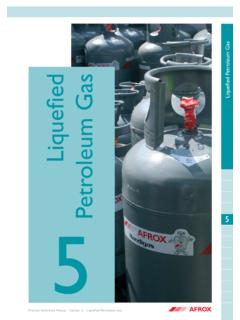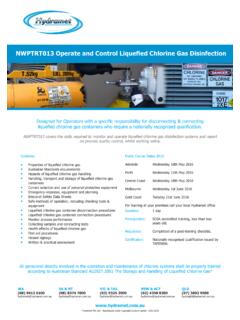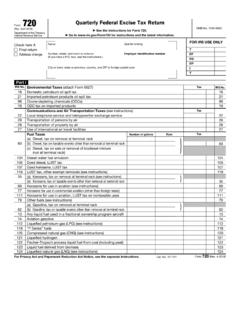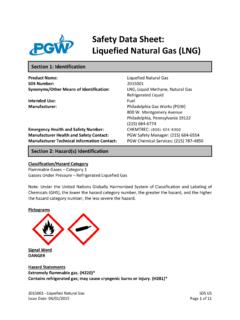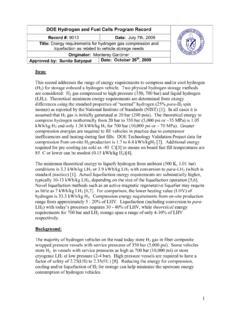Transcription of Safe use of liquefied petroleum gas (LPG) at small ...
1 Safe use of liquefied petroleum gas (LPG) at small commercial and industrial bulk installations When the risks are properly identified and managed, LPG can be safely used as a fuel source for many applications. This information is aimed primarily at users of LPG to provide information and help to ensure it is used safely. Users may wish to consider recording information about their installation, such as the route of any pipework, risk assessments they may make and any maintenance undertaken. Initially the site will concentrate on people using small bulk LPG installations. Included in this is information on the bulk storage tank and service pipework. Bulk LPG storage tank Safety of your LPG storage tank This is the bulk storage tank for the LPG used on this site. For the type of installations covered in this example, this tank can store up to four tonnes of LPG. In some cases, more than one tank may be used to store the LPG.
2 In the vast majority of cases the tank will be owned by the company that supplies the gas, but if you are unsure then you should check this with your own supplier. In general, the supplier will look after the tank and its fittings (their integrity and maintenance) but again check this with your supplier if you are unsure, as legally it needs to be maintained in a safe condition. The user of the LPG (ie the person operating the site) does have responsibilities in relation to the tank including: Siting of the tank Ventilation and conditions around the tank Tanker access Security Impact protection Emergency arrangements The legal framework provides more information on the background to these responsibilities. Siting of the tank There should be a minimum distance (called the separation distance) between the tank and any building, boundary line or fixed source of ignition.
3 This should have been checked when the tank was first installed and the supplier will know what the distance should be if you are unsure. Modifications to the area may have been made since the tank was installed. These could include altering walls, building sheds or fences, installing electrical equipment near the tank or planting trees or shrubs nearby. These should not be any closer to 1 the tank than this minimum distance and, if they are, then arrangements need to be made to move them. There should not be any drains or gullies near to the tank unless a water trap is provided to prevent gas entering the drains. This is because LPG is heavier than air and if a leak were to develop from the tank or its controls or pipework or when it is being filled then the vapour could accumulate in an untrapped drain or gully. Ignition of these vapours could then lead to fire/explosion.
4 The tank should also not be painted in any colour other than originally supplied as this may increase the amount of heat it absorbs from the sun. This picture shows a well-sited tank: Ventilation and conditions around the tank In case of leaks there should be plenty of room around the tanks to ensure good air flow so that pockets of heavier-than-air LPG vapours cannot build up around them. It is also very important to keep the area around the tank free of rubbish, particularly if it is combustible or could reduce the levels of ventilation. For similar reasons keep weeds and grass cut down around the tank. If you choose to use a weed killer then you should not use something that is chlorate-based (as this can make the dead plants easier to ignite). 2 3 Tanker access There should be a dedicated flat parking area for the tanker delivering LPG. This parking area should be clear on a delivery day and people should be kept away from the tank and tanker while the transfer of LPG is taking place.
5 The supplier of the LPG will need to make sure that the tanker cannot drive away with the supply hose still connected, that there is no risk of an electrical spark being generated from static electricity or by other means. The LPG suppliers should ensure that their drivers are suitably trained and have the correct procedures to follow. Security People not involved with the installation, for example workers with no responsibility for the LPG or visitors to the site, should be kept well away from it. No one should smoke, use electrical equipment or park vehicles near the tank . No smoking and other signs should be clearly displayed and maintained. Ignition sources, eg bonfires and barbecues, should not be allowed near the tank. Temporary use of grass-cutting equipment within the vicinity of the tank is permitted. The tank should be protected from unauthorised access to reduce the chance of intentional or accidental interference.
6 For larger tanks (ie four tonnes or higher LPG capacity) a security fence is required to keep it secure. This fence should allow natural air flow (eg made from wire mesh) and should be kept in good condition. Any gates should be kept locked unless access to the tank is required. For tanks below four tonnes LPG capacity, there may be certain circumstances where a fence may not be necessary. This can only be justified where the risk of interference is low, and there is no uncontrolled public access - for example due to tank location or other accessibility factors. Tank valve covers should be kept locked whether or not the tank is fenced. Impact protection If possible, the tank (and its associated piping) should not be located in areas where there is motor traffic. However, where this is not possible, then protection from a motor vehicle hitting the tank is required such as crash barriers or bollards.
7 A security fence and/or road markings (eg no-parking notices, double yellow lines) are unlikely to provide this protection. 4 Emergency arrangements The LPG tank will have printed on it the supplier s emergency number that should be called if there is a leak. If a fire breaks out then the user should have in place an emergency plan which includes evacuating people from the premises. In general, leave tackling any fire near the tank to the fire brigade unless it is judged that it can be put out without endangering anyone. In the event of an emergency, and where it is safe to do so, the shut-off valve on the top of the tank and the emergency control valve (ECV) should be closed. Service pipework Looking after your service pipes Owners of service pipework therefore have some important responsibilities and should consider the following: Installation route Materials of construction Pressure Inspection and maintenance Replacement Entry into the premises The legal framework provides more information on the background to these responsibilities.
8 Installation route Ideally, LPG service pipework should be run above ground using a route that minimises the possibility of physical damage, for example from vehicles, and away from excessive heat or cold. Where damage can be foreseen, protective barriers, bollards etc should be provided. If it is not possible to run the pipework above ground, then it can be buried underground and, in such cases, it is important to know its route and to mark it so that others are aware of it. Where traffic or other heavy loads pass over the pipe, protection should be provided, such as load-bearing slabs or covers. 5 The pipe that carries the LPG vapour from the bulk storage tank to the building is called the service pipework. This is most likely to be owned by whoever owns the premises using the LPG this could be the landlord if the premises are rented. It is normally not owned by the LPG supplier, even though it may have been installed by them.
9 If you are not sure about ownership of the pipework, then you should check with your supplier and/or landlord if you do not own the property or land yourself. The main concern with service pipework is that if it is damaged it is likely to release the LPG it is carrying. If the escaping LPG vapours were to ignite, the LPG could then cause a fire or explosion. Damage to the pipework could be caused by physical impact or through chemical means, for example corrosion of a metal service pipe. For the majority of premises, it is likely that service pipework will already be installed. If this is the case then for buried pipework it is important to ensure that its route is known, recorded and, where possible, clearly marked. If the pipework is to be replaced, then think about replacing it with pipework that runs above ground if at all possible. If not then it should be replaced with non-corroding pipework made of material such as polyethylene (PE).
10 Materials of construction The material the pipework is made from is very important, particularly if it is buried. In general, steel or copper can be used for pipework that runs above ground. Where pipework needs to be buried then it should be made of material, such as polyethylene, that is non-corroding. This is important because corrosion of buried metallic pipework can result in leaking of LPG and this could lead to a fire or explosion if it accumulates and is ignited. Buried pipework installed within the last 15 years is likely to be made of non-corroding material, such as polyethylene. Older installations, though, may have buried metallic pipework. In these cases, the pipework is likely (but not always) to have some form of corrosion protection provided (for example it may have been wrapped in a special protective tape). This protection will not last indefinitely and the pipes will corrode over time.










